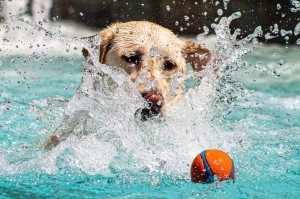Cooler heads prevail: New research reveals best way to prevent dogs from overheating
 As temperatures continue to soar across the country, a simple yet innovative technique could be the key to keeping dogs safe from heat-related illnesses.
As temperatures continue to soar across the country, a simple yet innovative technique could be the key to keeping dogs safe from heat-related illnesses.
New research published in the Journal of the American Veterinary Medical Association(JAVMA) reveals that teaching dogs to voluntarily dunk their heads in water is the most effective method for rapidly cooling them down after exercise. The study, conducted by researchers at the Penn Vet Working Dog Center at the University of Pennsylvania, compared various cooling methods and found that voluntary head dunking not only cooled dogs faster than other techniques but also prevented dangerous post-exercise temperature spikes.
This method could be a game-changer for dog owners and handlers, especially in situations where access to large quantities of water is limited.
This study changes our understanding of cooling methods in the dog,” said Dr. Cynthia M. Otto, lead author of the study and executive director of the Penn Vet Working Dog Center. “During heat stress, blood flow to the head, nose, tongue and ears is increased. Cooling the tissues of the head allows for rapid cooling of the whole body with limited amounts of water. Furthermore, training the dog to participate in the cooling process can enhance not only its safety, but the human animal bond.”
The importance of cooling dogs quickly
Heat-related illness is a serious risk for dogs, especially during warm weather when dogs can quickly overheat during activities, putting them at risk of heat injury or heat stroke. The research emphasizes the critical rule of “Cool first, transport second,” which encourages owners to begin cooling dogs immediately if they show signs of heat stress, before seeking veterinary care.
Among the methods tested, only the voluntary head dunking technique, where dogs are trained to dip their heads into water, prevented dangerous post-exercise temperature spikes, while also cooling dogs faster than the other methods.
Simple technique, big benefits
As described in the research, voluntary head dunking uses positive reinforcement training to encourage and reward dogs for submerging their heads in a bucket of water to retrieve a toy or treat. Clean room temperature water is added stepwise until the dog is comfortable immersing its head to retrieve the toy or treat.
By teaching dogs to perform this task, owners can help their pets flush their noses and eyes of dust and debris while also providing quick relief from overheating. The research found that dogs trained in this technique could cool down more rapidly after exercise compared to other cooling methods. Additionally, the head dunking can help clear debris from a dog’s nose and eyes, making it a versatile first-aid tool.
The researchers recommend training dogs in this technique, as it could serve as a valuable skill in the event of heat stress, especially during outdoor activities like hiking or running. It’s important to note that training may take anywhere from a few days to several weeks, depending on the individual dog’s comfort level and motivation.
Practical application for dog owners
As summer continues and many pet owners enjoy outdoor activities with their dogs, these studies provide timely and relevant information for pet owners. Whether for canine athletes, working dogs, or pets enjoying a day at the park, the head dunking method offers a simple way to manage heat stress.
To learn more about these cooling methods and the cooperative care training involved, dog owners should consult with their veterinarians and consider incorporating these techniques into their pets’ routines.
To view the study, visit https://doi.org/10.2460/javma.24.06.0368. In addition, an accompanying tutorial video is available at https://doi.org/10.2460/javma.24.07.0480.
Additional hot weather safety tips for pet owners
Pet owners should be aware that if it’s hot outside for humans, it’s likely even hotter for pets. There’s no set temperature where heat becomes dangerous, as risk can vary based on a pet’s physical characteristics, age, weight, underlying medical conditions and activity level. In general, pets with longer or darker fur, flat-faced breeds, older pets, obese pets, or those with certain medical conditions may be at increased risk of heat-related illness.
It’s crucial for pet owners to recognize the signs of heat stress or heat stroke in their animals. These can include:
- Anxiousness
- Elongated tongue
- Flattened, retracted ears
- Narrowed eyes
- Shade seeking
- Excessive panting where the molars are easily visible and drooling – especially thick ropey saliva
- Vomiting or diarrhea (sign of more serious heat injury)
- Abnormal gum and tongue color (dark red)
- Unsteadiness/collapse (collapse is indication of an emergency)
If any of these signs are observed, owners should begin cooling efforts immediately and seek emergency veterinary care.
To prevent heat-related issues, pet owners should provide constant access to water and shade for outdoor pets. On particularly hot days, it’s best to keep pets indoors or limit outdoor time to early morning or evening hours when temperatures are cooler. Never leave pets alone in vehicles, even for short periods, as temperatures can rise dangerously high within minutes.
Additionally, be mindful of hot pavement, which can burn paw pads. Consider using protective booties or walking on grass when possible. By taking these precautions and being aware of their pet’s individual needs, owners can help ensure their furry companions stay safe and comfortable during warm weather.
Pet owners can learn more about warm weather pet safety at https://www.avma.org/resources/pet-owners/petcare/warm-weather-pet-safety.
Short URL: http://caninechronicle.com/?p=304359
Comments are closed












